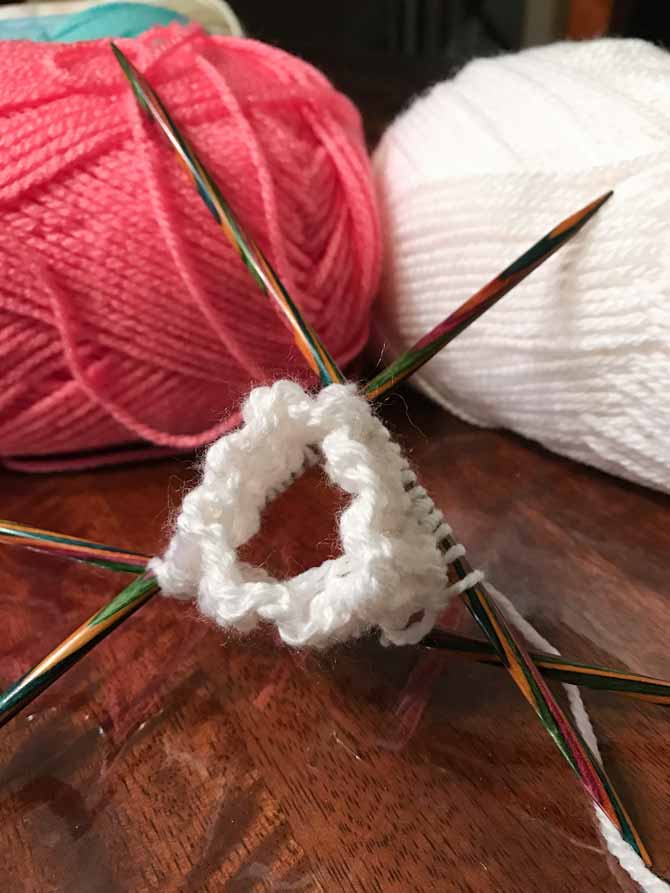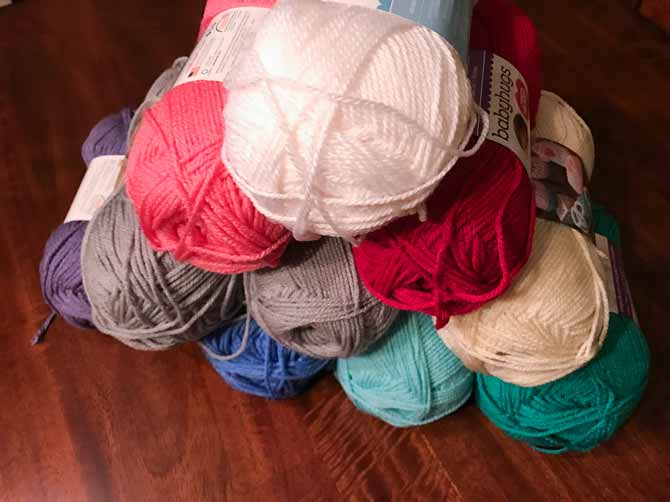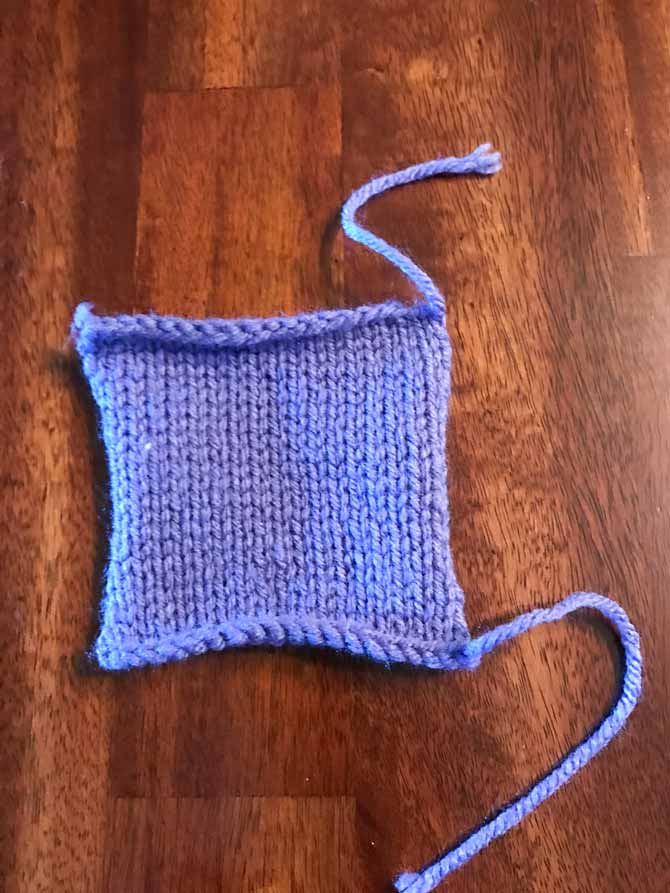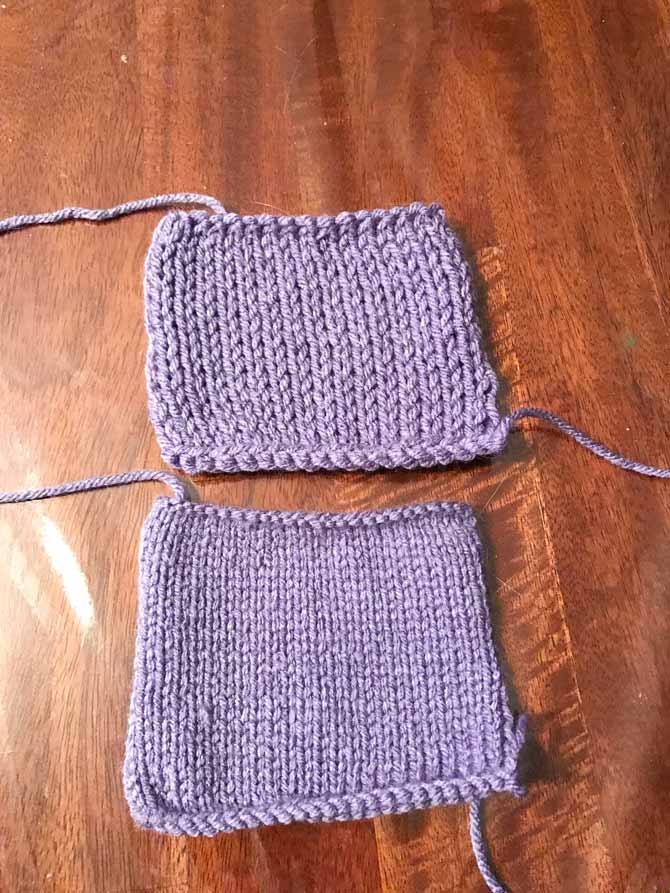Imagine: you go into your LYS and you have a pattern in mind. It calls for Baby Hugs in Medium, and when you get there, you see the most stunning color. You pick it up and curse your bad luck because it’s in Baby Hugs Light. The same color isn’t available in the Medium — it’s sold out because it’s the most popular color! What are you going to do?

Baby Hugs Light yarn in the colors Pinkie and Frosting being knit in the round on double pointed needles
A lot of knitters would put that skein back on the shelf or buy it to use on another pattern, but today we’re going to go over one of the skills needed to substitute a different yarn weight in a pattern. There are several ways to do this, but we’re going to look at one of the easiest; changing needle size.
I’ll put a disclaimer here: always verify your fiber choice! Just because you can make socks out of fun fur, doesn’t mean that you should. Ensure that if you’re making an item that will get a lot of wear and tear, the fiber will hold up. Alpaca might feel luxurious, but 100% alpaca socks aren’t going to last long. In the same vein, make sure the washing instructions are going to fit in with your lifestyle. If you never have the time to hand-wash, make sure you are either producing a garment that doesn’t require a lot of washing or you’re prepared to commit to washing that garment every time you wear it!

Make your fiber choice the right one for your lifestyle!
Let’s go over the needle difference first, because that’s going to be the easiest way out of changing your pattern or yarn. Check your pattern gauge; there will be a needle size, along with a gauge that will make a square 4″ x 4″. This is the gauge you want to get with your yarn and needles. For the sake of this example, let’s say you want to get 20 stitches to 4″.
Take the recommended needle size for that yarn and make a swatch. No cutting corners either, you need to make that swatch at least 4″ x 4″, this does not count borders. This isn’t a beauty contest, we just need to know what the gauge is going to be. If you don’t get 4″ with 20 stitches right on, adjust your needle size up or down until you have it.

One 4″ X 4″ swatch in Baby Hug yarn in Lilac. This swatch was knit with the recommended needle size of 9 US [5.5mm] needle.
If you’re not sure if you should go up a needle size or down a needle size, just remember that the needles control the size of the space in-between your yarn. If you go up a lot, you’re going to have a breezy garment, if you go down a lot, it’s going to be very warm and dense. Once you’ve arrived at the right needle size and your gauge is right on, see if you like the fabric. Imagine your whole garment being made like this swatch. Have you gone down so many needle sizes that the sweater would stand on its own like a lampshade, or have you gone up so many sizes that you would be able to see right through it?

The top swatch was knit with an 11 US [8mm] needle, can you see how much larger it looks from the picture above? The bottom swatch is knit with a 5 US [3.75mm] needle, there is barely any space between the stitches.
When you’re substituting a yarn that’s close to the pattern yarn (say the pattern calls for DK, and you have a worsted yarn) changing needle sizes offers a great chance for success without a lot of re-calculating.
If you’re not happy with the fabric, you can do the math. If you’re picking a drastically different yarn weight, for example, if you’re going from a Medium to a Super Fine, that’s something you’ll have to figure out with a calculator. The most important thing when you’re going through this process is that you be 100% happy with your finished object. When you can pair your perfect yarn with your perfect pattern, it’s a recipe for knitting ambrosia.
This is part 4 of 5 in this series.
Go back to part 3: Knit the best wrister pattern EVER!
Go to part 5: A boring hat? Never again with this easy knitting pattern

14 comments
OMG, thank you so much for the link to the math, that is exactly what I’ve been trying to find! I’m coming to knitting from weaving and the lack of technical information has been so frustrating. Thanks again!
hi. what color are the two swatches in the last photo?
Hi! The color of the last two swatches in this post, are both Lilac. The lighting causes the last swatch to look darker/’bluer’. This is Red Heart Baby Hugs Lilac colorway. Thanks for asking.
Where do I find the mathematical equations needed to figure out how much yarn is needed when using a drastically different weight yarn for a project? Is there a chart that says (for example) 100 yards of worsted weight (4) yarn is equal to How many yards of a Fine weight (1) yarn? I have been trying to find the answer to this questions for years and keep looking at the expensive yarn I have but cant figure out how much would be needed when the pattern calls for a worsted weight yarn.
If I use DK wool and follow a 4ply pattern, how much bigger would the jumper be please?
Okay, I want to knit an oversized shawl pattern in a Worsted wt, yarn. The pattern calls for Super bulky wt. using a size 17 needle to get gauge of 9 stitches and 13 rows = 4 inches. The yarn I want to use says 4.4-5 st. = 1 inch on 6-9 needles. The super bulky yarn gauge is 2 st = 1” on 15 needles. Do you think I can substitute the Worsted weight yarn for the super bulky wt. yarn in this pattern? Oh, and the yarn used in the pattern is 50%alpaca 50% Wool Blue Sky Fibers Super Bulky. The yarn I want to use is Knit Picks Chroma Worsted Yarn 79%superwash. wool 30% nylon
Thank you for your help. Barbara
I have a pattern calling for so yarn. I wanted to use bulky. How do I adjust the stitching? Thank you.
What is the math involved? I have this beautiful worsted wool and a terrific pattern, however the guage marked yields a very stiff piece. Using a size larger needles does not help. Thanks.
I have a pattern for a jumper in chunky but I have aran wool ~ will it work if I change the needle size?
Hello Maria, I would give it a try. Knit a swatch to see how your gauge is effected. Use those measurements to see how your garment will change with the different needle size.
I have been given some beautiful super chunky yarn. I have an Aran pattern that I would like to follow using this super chunky yarn. Any help to do this would be greatly appreciated .
Hello Gill! What kind of garment is the aran pattern for?
I do not see how you discussed changeing from a yarn such as a worsted to say a DK. You discuss needle size as one way but you do not say how to figure out the increased or decreased number of stitches necessary to use the smaller yarn size to make the same garmet come out correctly .
There is a way to figure out the new number of stitches to cast on and so forth to get the same garmet with the smaller yarn.
Hello Kari, there is a way to change out the yarn and have the pattern come out the size you want it, but it involves a lot of math. When you’re making smaller pattern adjustments you will be able to tell if your adjustments are going to work because of your swatch. You make sure the needles and amount of stitches cast on with the yarn you are currently knitting with match the recommended watch size on the pattern. This is a quick and dirty way to sub in a different size yarn to a pattern. Always knit and measure a swatch and it will show you the way!! :D